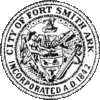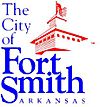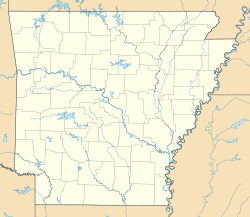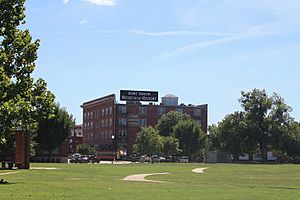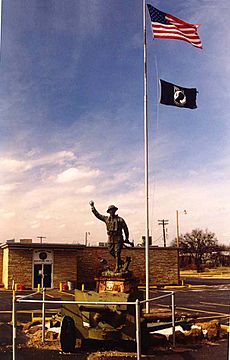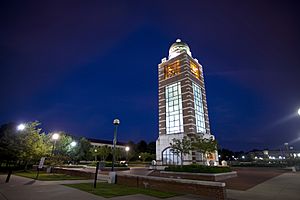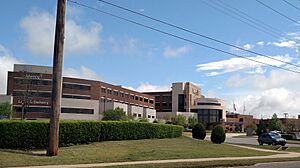Fort Smith, Arkansas facts for kids
Quick facts for kids
Fort Smith, Arkansas
|
|||||
|---|---|---|---|---|---|
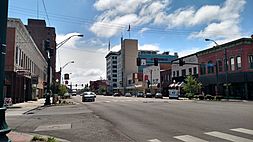
Downtown Fort Smith
|
|||||
|
|||||
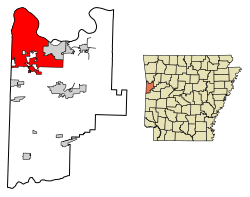
Location of Fort Smith in Sebastian County, Arkansas.
|
|||||
| Country | United States | ||||
| State | Arkansas | ||||
| County | Sebastian | ||||
| Founded | 1817 | ||||
| Incorporated | December 24, 1842 | ||||
| Area | |||||
| • City | 68.23 sq mi (176.72 km2) | ||||
| • Land | 63.99 sq mi (165.74 km2) | ||||
| • Water | 4.24 sq mi (10.98 km2) | ||||
| Elevation | 463 ft (141 m) | ||||
| Population
(2020)
|
|||||
| • City | 89,142 | ||||
| • Density | 1,392.97/sq mi (537.83/km2) | ||||
| • Urban | 122,947 (US: 257th) | ||||
| • Metro | 279,974 (US: 165th) | ||||
| GDP | |||||
| • Metro | .024 billion (2022) | ||||
| Time zone | UTC−6 (CST) | ||||
| • Summer (DST) | UTC−5 (CDT) | ||||
| ZIP codes |
72901-72906, 72908, 72913-72914, 72916-72919
|
||||
| Area code(s) | 479 | ||||
| FIPS code | 05-24550 | ||||
| GNIS feature ID | 2403647 | ||||
| Interstate Highways | I-40, I-49, I-540 | ||||
| Other major highways | US 64, US 71, US 271 | ||||
Fort Smith is the third-largest city in Arkansas, United States. It is one of the two main cities in Sebastian County. In 2020, about 89,142 people lived there. Fort Smith is the main city of a larger area that includes parts of Arkansas and Oklahoma, with nearly 300,000 residents.
The city is located right on the border between Arkansas and Oklahoma. It sits where the Arkansas River and Poteau rivers meet, a spot known as Belle Point. Fort Smith started as a military base in 1817 and was also a place for fur trading. It became famous as a starting point for people moving west into the "Wild West." It was also known for its law enforcement, especially for keeping order in the nearby Indian Territory.
The city is led by Mayor George McGill, who was elected in 2018. He was the first African American mayor in Fort Smith's history. The city also has a Board of Directors with seven members.
Contents
History of Fort Smith
The land where Fort Smith is located became part of the United States in 1803 through the Louisiana Purchase. In 1817, Fort Smith was founded as a military outpost. A small fort was built and used by soldiers until 1822. A small town began to grow around the fort.
In 1824, the Army moved its base further west. But a man named John Rogers bought the old government lands. He helped the new town of Fort Smith grow. Because of his efforts, the government brought the military back to Fort Smith. This happened during a time when many Native American tribes were being moved from their homes.
Fort Smith got its name from General Thomas Adams Smith. In 1817, he ordered an engineer to find a good spot for a fort on the Arkansas River. General Smith never actually visited the town or the forts named after him.
In 1838, the Army returned to the old fort site. They made the base bigger as part of a plan to move Cherokee and Choctaw people to the nearby Indian Territory. Many Native Americans settled in Fort Smith and nearby Van Buren. Sebastian County was formed in 1851.
Fort Smith became an important stop for the Butterfield Overland Mail in 1858. This was a mail route that crossed the Indian Territory into Texas.
During the American Civil War, Confederate soldiers took control of Fort Smith. But Union troops took it back on September 1, 1863. There was a small fight there in 1864, but the Union army stayed in charge until the war ended in 1865. The town became a safe place for runaway slaves and others affected by the war. The federal troops left Fort Smith for good in 1871. Even without the soldiers, the town continued to grow.
Two very important people in Fort Smith's history were Judge Isaac Parker and William Henry Harrison Clayton. In 1874, William Clayton became the United States Attorney for the area. Fort Smith was a wild place with many outlaws, right next to Indian Territory. Clayton knew they needed a strong judge to bring law and order. He found Judge Isaac Parker. With help from President Ulysses S. Grant, Judge Parker was sent to Fort Smith.
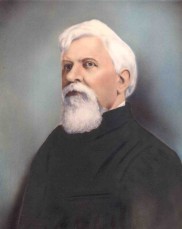
William Clayton served as US Attorney under four different presidents. He later became the Chief Justice of Indian Territory. He helped Oklahoma become a state in 1907.
The Army came back to Fort Smith in 1941 when Fort Chaffee Military Reservation was built east of the city.
On April 21, 1996, a large tornado hit Fort Smith. It damaged much of the historic downtown area. Four people died in western Arkansas because of the storm. Days later, a big fire destroyed a furniture building in downtown Fort Smith.
Geography and Climate
Fort Smith is located at 35°22′7″N 94°23′55″W / 35.36861°N 94.39861°W.
The city covers about 64.6 square miles (167.3 km2). Most of this is land, with about 3.9 square miles (10.1 km2) being water.
Fort Smith Weather
Fort Smith usually has mild winters and hot, humid summers.
- The average temperature in January is about 39.4°F (4.1°C).
- The average temperature in July is about 82.3°F (27.9°C).
- Temperatures reach 90°F (32°C) about 75 days a year.
- Temperatures reach 100°F (38°C) about 11 days a year.
- The lowest temperature ever recorded was −15°F (−26°C) in 1899.
- The highest temperature ever recorded was 115°F (46°C) in 2011.
Fort Smith is near an area called Tornado Alley. The city has been hit by major tornadoes in 1898, 1927, and 1996.
| Climate data for Fort Smith Regional Airport, Arkansas (1981–2010 normals, extremes 1882–present) | |||||||||||||
|---|---|---|---|---|---|---|---|---|---|---|---|---|---|
| Month | Jan | Feb | Mar | Apr | May | Jun | Jul | Aug | Sep | Oct | Nov | Dec | Year |
| Record high °F (°C) | 81 (27) |
87 (31) |
94 (34) |
96 (36) |
99 (37) |
106 (41) |
111 (44) |
115 (46) |
109 (43) |
96 (36) |
86 (30) |
82 (28) |
115 (46) |
| Mean daily maximum °F (°C) | 49.9 (9.9) |
55.4 (13.0) |
64.7 (18.2) |
73.7 (23.2) |
80.5 (26.9) |
88.1 (31.2) |
93.0 (33.9) |
93.4 (34.1) |
85.4 (29.7) |
74.8 (23.8) |
62.8 (17.1) |
51.5 (10.8) |
72.8 (22.7) |
| Mean daily minimum °F (°C) | 29.0 (−1.7) |
33.1 (0.6) |
41.1 (5.1) |
49.5 (9.7) |
59.2 (15.1) |
67.5 (19.7) |
71.6 (22.0) |
70.8 (21.6) |
62.3 (16.8) |
50.7 (10.4) |
40.3 (4.6) |
31.2 (−0.4) |
50.6 (10.3) |
| Record low °F (°C) | −11 (−24) |
−15 (−26) |
7 (−14) |
22 (−6) |
34 (1) |
47 (8) |
50 (10) |
45 (7) |
33 (1) |
22 (−6) |
8 (−13) |
−5 (−21) |
−15 (−26) |
| Average precipitation inches (mm) | 2.81 (71) |
2.76 (70) |
3.85 (98) |
4.30 (109) |
5.47 (139) |
4.28 (109) |
3.30 (84) |
2.59 (66) |
4.05 (103) |
4.32 (110) |
4.44 (113) |
3.29 (84) |
45.46 (1,155) |
| Average snowfall inches (cm) | 2.4 (6.1) |
1.1 (2.8) |
0.6 (1.5) |
0.0 (0.0) |
0.0 (0.0) |
0.0 (0.0) |
0.0 (0.0) |
0.0 (0.0) |
0.0 (0.0) |
0.0 (0.0) |
trace | 0.8 (2.0) |
4.9 (12) |
| Average precipitation days (≥ 0.01 in) | 7.5 | 7.8 | 9.7 | 9.1 | 10.7 | 9.3 | 6.5 | 6.3 | 7.7 | 8.4 | 7.5 | 7.7 | 98.2 |
| Average snowy days (≥ 0.1 in) | 1.1 | 0.8 | 0.4 | 0.0 | 0.0 | 0.0 | 0.0 | 0.0 | 0.0 | 0.0 | 0.0 | 0.7 | 3.0 |
| Average relative humidity (%) | 69.5 | 67.6 | 63.9 | 63.8 | 70.7 | 70.9 | 68.9 | 68.6 | 71.8 | 69.4 | 70.3 | 71.2 | 68.9 |
| Mean monthly sunshine hours | 173.5 | 172.5 | 215.2 | 236.1 | 274.8 | 304.0 | 327.6 | 294.5 | 233.1 | 220.7 | 162.5 | 156.3 | 2,770.8 |
| Percent possible sunshine | 55 | 56 | 58 | 60 | 63 | 70 | 74 | 71 | 63 | 63 | 52 | 51 | 62 |
| Source: NOAA (sun and relative humidity 1961–1990) | |||||||||||||
Fort Smith Population Facts
| Historical population | |||
|---|---|---|---|
| Census | Pop. | %± | |
| 1840 | 144 | — | |
| 1850 | 964 | 569.4% | |
| 1860 | 1,532 | 58.9% | |
| 1870 | 2,227 | 45.4% | |
| 1880 | 3,099 | 39.2% | |
| 1890 | 11,311 | 265.0% | |
| 1900 | 11,587 | 2.4% | |
| 1910 | 23,975 | 106.9% | |
| 1920 | 28,870 | 20.4% | |
| 1930 | 31,429 | 8.9% | |
| 1940 | 36,584 | 16.4% | |
| 1950 | 47,942 | 31.0% | |
| 1960 | 52,991 | 10.5% | |
| 1970 | 62,802 | 18.5% | |
| 1980 | 71,626 | 14.1% | |
| 1990 | 72,798 | 1.6% | |
| 2000 | 80,268 | 10.3% | |
| 2010 | 86,209 | 7.4% | |
| 2020 | 89,142 | 3.4% | |
| U.S. Decennial Census | |||
| Race / Ethnicity (NH = Non-Hispanic) | Pop 2000 | Pop 2010 | Pop 2020 | % 2000 | % 2010 | % 2020 |
|---|---|---|---|---|---|---|
| White alone (NH) | 59,436 | 55,654 | 50,728 | 74.05% | 64.56% | 56.91% |
| Black or African American alone (NH) | 6,874 | 7,621 | 7,602 | 8.56% | 8.84% | 8.53% |
| Native American or Alaska Native alone (NH) | 1,254 | 1,408 | 1,555 | 1.56% | 1.63% | 1.74% |
| Asian alone (NH) | 3,661 | 4,524 | 5,103 | 4.56% | 5.25% | 5.72% |
| Pacific Islander or Native Hawaiian alone (NH) | 29 | 59 | 65 | 0.04% | 0.07% | 0.07% |
| Other race alone (NH) | 48 | 66 | 227 | 0.06% | 0.08% | 0.25% |
| Mixed race or Multiracial (NH) | 1,918 | 2,687 | 6,396 | 2.39% | 3.12% | 7.18% |
| Hispanic or Latino (any race) | 7,048 | 14,190 | 17,466 | 8.78% | 16.46% | 19.59% |
| Total | 80,268 | 86,209 | 89,142 | 100.00% | 100.00% | 100.00% |
2020 Census Information
| Race | Number | Percentage |
|---|---|---|
| White (non-Hispanic) | 50,728 | 56.91% |
| Black or African American (non-Hispanic) | 7,602 | 8.53% |
| Native American | 1,555 | 1.74% |
| Asian | 5,103 | 5.72% |
| Pacific Islander | 65 | 0.07% |
| Other/Mixed | 6,623 | 7.43% |
| Hispanic or Latino | 17,466 | 19.59% |
In 2020, Fort Smith had 89,142 people living in 36,210 households. About 22,349 of these were families.
2010 Census Information
In 2010, Fort Smith had 86,209 people. The city had about 1,391 people per square mile (537.2/km2).
- About 69.3% of the people were White.
- About 9.0% were Black or African American.
- About 1.8% were Native American.
- About 5.3% were Asian (including Vietnamese, Laotian, and others).
- About 10.3% were from other races.
- About 4.2% were from two or more races.
- About 16.5% of the population was Hispanic or Latino.
Many different languages are spoken in Fort Smith. Besides English, Spanish is spoken by about 7.10% of people at home. Vietnamese and Lao are spoken by about 3.38%, and Tagalog by about 2.50%.
In 2000, about 30.8% of households had children under 18. The average household had 2.42 people, and the average family had 3.03 people. The median age in the city was 35 years. For every 100 females, there were about 94.1 males. The average income for a household was $32,157. About 15.8% of the population lived below the poverty line.
Fort Smith Economy
Fort Smith is a big center for manufacturing. Many large companies have factories here, such as Rheem, Trane, Georgia-Pacific, Gerber, Kraft Heinz Company-Planters Peanuts, and Mars Petcare.
Several important companies are based in Fort Smith, including ABB Motors & Mechanical, ArcBest, and the poultry company OK Foods.
Here are some of the top employers in Fort Smith:
| # | Employer | # of Employees |
|---|---|---|
| 1 | Baptist Health | 2,400 |
| 2 | ABB Motors & Mechanical | 2,393 |
| 3 | OK Foods | 1,800 |
| 4 | Fort Smith Public Schools | 1,783 |
| 5 | Mercy Hospital Fort Smith | 1,487 |
| 6 | 188th Fighter Wing (Air National Guard) | 1,100 |
| 7 | University of Arkansas at Fort Smith | 951 |
| 8 | ArcBest | 936 |
| 9 | City of Fort Smith | 914 |
| 10 | Rheem-Ruud | 900 |
Fort Smith Culture
Many TV shows and movies have been filmed in Fort Smith. Some examples include The Blue and The Gray (1982), A Soldier's Story (1984), and Biloxi Blues (1988).
Museums in Fort Smith
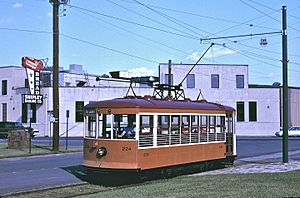
Fort Smith has many museums, mostly in the downtown area and the Chaffee Crossing Historic District.
- Fort Smith Regional Art Museum opened in 2013.
- Fort Smith Museum of History is near the National Historic Site. It has many exhibits and items that tell the story of Fort Smith, from its start as a fort to its role in the Civil War and becoming a modern city.
- Fort Smith Trolley Museum is a railroad museum with old trolleys and related items. You can even take trolley rides!
- Fort Smith Air Museum shows the history of aviation in Western Arkansas and Eastern Oklahoma.
- The Clayton House Museum was the home of William H.H. Clayton, who was a US Attorney. It is open for tours and tells the story of Mr. Clayton and the Wild West.
- Chaffee Barbershop Museum is where Elvis Presley got his famous G.I. buzz cut on March 25, 1958, when he joined the Army.
- The United States Marshals Museum teaches about the history of the United States Marshals Service, which is America's oldest federal law enforcement agency.
Music Scene
Fort Smith has a lively music scene. You can often find live performances of Jazz, Blues, Country, and Rock bands in the downtown area.
- Fort Smith Symphony is a professional orchestra that performs regularly at the ArcBest Performing Arts Center.
Fort Smith Attractions
As the third-largest city in western Arkansas, Fort Smith has many fun things to do. Its theaters and venues often host big concerts and touring shows.
Event Venues
- Riverfront Amphitheater is next to the Arkansas River and is part of the River Park Complex.
- Fort Smith Convention Center is one of the largest convention centers in the region. It has a performing arts theater where the Fort Smith Symphony plays.
- Kay Rodgers Park has the Expo Center and the Harper Arena, which can hold many people for different events.
- The Blue Lion is a center for performing and visual arts with a theater and an art gallery.
Shopping in Fort Smith
Fort Smith is a major shopping spot for Western Arkansas and Eastern Oklahoma. Central Mall is the largest indoor shopping center in the state.
Some popular shopping areas in Fort Smith include:
- Rogers Avenue (with Central Mall, GreenPointe Shopping Center, and more)
- Phoenix Avenue/Greenwood Ave. (with Fort Smith Pavilion and Phoenix Center)
Fort Smith Landmarks
- Fort Smith National Historic Site is the most famous landmark. It has the remains of the first fort from 1817. You can see the restored courtroom of the famous "Hanging Judge" Isaac C. Parker and the old frontier jail called "Hell on the Border." This nickname eventually became an unofficial nickname for Fort Smith itself.
- Belle Grove Historic District is a 22-block area downtown with nearly 25 restored homes. These homes show different building styles from over 130 years.
- Clayton House Museum was the home of W. H. H. Clayton, who worked with Judge Isaac Parker. It was built in 1882.
- Fort Chaffee is mainly used today as a training place for military units. In 1958, Elvis Presley stopped at Fort Chaffee on his way to basic training. This is where he got his famous military haircut.
Annual Events
- Peacemaker Music Fest is held every summer at the Riverfront Amphitheater.
- Unexpected - Urban Contemporary Art Festival happens each fall, featuring amazing artists.
- Fort Smith Riverfront Blues Fest has been held since 1991 along the Arkansas River.
- Steel Horse Rally is a motorcycle event held each spring to raise money for local charities.
- Arkansas-Oklahoma State Fair is a ten-day fair held in late September.
- Old Fort Days Rodeo is Fort Smith's annual rodeo, held every May since the 1930s.
- Fort Smith Brewing Anniversary celebrates the city's only brewery each September.
- Hanging Judge Border Feud High School Rodeo is held each March or April at Kay Rodgers Park.
- Fort Smith Juneteenth Community Festival celebrates the end of slavery in the United States.
Sports and Recreation
Fort Smith has many sports programs and tournaments.
- Fort Smith Marshals (baseball)
- Fort Smith Marathon
- Battle at the Fort Volleyball Tournament
- United Way Charity Golf Classic
- Fort Smith Tournament of Champions (high school basketball)
- Fort Smith Church League Baseball
- Ben Geren Softball Association
- River Valley Futbol Club (soccer)
- River Valley Cycling Club
- Western Arkansas Pickleball Association
Education in Fort Smith
Higher Education
Fort Smith has one main university, the University of Arkansas at Fort Smith (UAFS). It started in 1928 as a junior college.
- It was first called Fort Smith Junior College.
- In 1950, it became a private, non-profit school.
- In 1952, it moved to its current location.
- Its name changed to Westark Junior College in 1966, then Westark Community College in 1972.
- In 1998, it became Westark College.
- In 2002, it joined the University of Arkansas System and became the University of Arkansas at Fort Smith. It now offers four-year bachelor's degrees, two-year associate degrees, and training programs.
Fort Smith also has the Arkansas College of Osteopathic Medicine (ARCOM), which opened in 2017. Students there can earn a Doctor of Osteopathic Medicine (DO) degree.
Schools for Kids
Most public schools in Fort Smith are run by the Fort Smith School District.
- The district has 26 schools.
- In 2019–2020, over 14,748 students were enrolled.
- It has 2 high schools, 4 middle schools, 19 elementary schools, and 1 alternative learning center.
Fort Smith public schools teach students from kindergarten to 12th grade. There are also private Protestant schools and Catholic schools.
Middle Schools in Fort Smith include:
- Chaffin Middle School
- Ramsey Middle School
- Kimmons Middle School
- Darby Middle School
Private schools include:
- Trinity Catholic School
- Union Christian Academy
- Northside Christian Academy
High schools in Fort Smith include:
- Public: Northside High School and Southside High School
- Private: Union Christian Academy and Northside Christian Academy
Some parts of southern Fort Smith are in the Greenwood School District.
Fort Smith Media
Newspapers and Magazines
- The Southwest Times Record is the biggest newspaper in the city.
- The Hispanos Unidos is the only Spanish-language newspaper in the area.
- Other publications include Entertainment Fort Smith and Do South Magazine.
Radio Stations
Here are some radio stations you can listen to in Fort Smith:
| Call letters | Frequency | Format |
|---|---|---|
| KFSA | 950 AM | Christian |
| KFPW | 1230 AM | Nostalgia |
| KWHN | 1320 AM | News Talk |
| KFSW | 1650 AM | Southern Gospel |
| KAOW | 88.9 FM | Religious |
| KBHN | 89.7 FM | Christian |
| KLFS | 90.3 FM | Christian |
| KLFH | 90.7 FM | Contemporary Christian |
| KUAF | 91.3 FM | Public Radio |
| KREU | 92.3 FM | Spanish |
| KISR | 93.7 FM | Top 40 |
| KFPW | 94.5 FM | Hard Rock |
| KERX | 95.3 FM | Sports |
| KKBD | 95.9 FM | Classic Rock |
| KZBB | 97.9 FM | Variety |
| KMAG | 99.1 FM | Country |
| KTCS | 99.9 FM | Country |
| KNSH | 100.7 FM | Country |
| KGDA-LP | 102.3 FM | Spanish Christian |
| KBBQ-FM | 102.7 FM | Urban/Hip Hop |
| KHGG | 103.5 FM | Sports |
| KQBK | 104.7 FM | Oldies |
| KZKZ | 106.3 FM | Christian |
| KEZA | 107.9 FM | Adult Contemporary |
Television Stations
Here are the TV stations in the Fort Smith area:
| Call letters | Channel Number | Network |
|---|---|---|
| KFSM | 5 | CBS |
| KAFT | 13 | PBS |
| KFTA | 24 | Fox |
| KWNL | 31 | Univision |
| KXNW | 34 | MyNetworkTV |
| KHBS | 40 | ABC |
| KFDF | 44 | Estrella TV |
| KNWA | 51 | NBC |
Fort Smith Infrastructure
Transportation
Fort Smith is an important place for transportation. It has major highways, is near the Arkansas River, and has railroad companies and a regional airport.
- Highways: Interstate 40 and Interstate 49 meet near Fort Smith. US 71 and US 64 also go through the city.
- Airport: The Fort Smith Regional Airport (FSM) is used by the military and has commercial flights to Dallas/Fort Worth.
- Bus Service: Jefferson Lines offers bus service to other cities like Little Rock and Kansas City.
- River Port: The city is on the Arkansas River, which is part of the McClellan-Kerr Navigation System. The Port of Fort Smith helps move goods by river.
- Railroads: Several railroad companies serve Fort Smith, connecting it to other parts of the country.
- Local Transit: Fort Smith Transit (FST) provides public bus service within the city. There is also a trolley-replica bus that runs in the downtown area. The Fort Smith Trolley Museum also has real trolleys for historic rides.
Utilities
Fort Smith gets its drinking water from two treatment plants, one near Lake Fort Smith and one on Lee Creek. The city is also working to upgrade its wastewater treatment facility.
Healthcare
Hospitals in Fort Smith include:
- Mercy Hospital Fort Smith
- Baptist Health-Fort Smith
- HealthSouth Rehabilitation Hospital
- Valley Behavioral Health System
- Mercy Orthopedic Hospital
- Select Specialty Hospital
Notable People from Fort Smith
Many interesting people were born in or lived in Fort Smith.
Athletes
- Martine Bercher, football player.
- Ron Brewer, basketball player.
- Kodi Burns, football player and coach.
- Ravin Caldwell, football player.
- Glen Condren, football player.
- Harry Feldman, baseball player.
- Jim Files, football player.
- Jack Fleck, professional golfer.
- Ryan Franklin, baseball pitcher and Olympic gold medalist.
- Craig Gentry, baseball player.
- Brett Goode, football player.
- Neale Henderson, Negro league baseball player.
- Priest Holmes, football player.
- Isaiah Joe, basketball player.
- Jim King, basketball player and NBA All-Star.
- Dat Nguyen, football player.
- Jahlil Okafor, professional basketball player.
- Scotty Robertson, basketball coach.
- Cole Rouse, racing driver.
- Jaylin Williams, basketball player.
Actors, Musicians, and Media Personalities
- Katharine Alexander, actress.
- James Cotten, film director and actor.
- Juliette Danielle, actress.
- Hunter Doohan, actor.
- Charlie Jones, sportscaster.
- Douglas C. Jones, author.
- Brandon Keener, actor.
- Jerry Keller, singer.
- Laurence Luckinbill, actor.
- Rudy Ray Moore, singer and actor.
- Brad Neely, web artist.
- Marty Stouffer, creator of Wild America TV series.
- Alphonso Trent, jazz bandleader and musician.
Politicians, Lawyers, and Judges
- John Boozman, United States Senator.
- Virgil Bozeman, Illinois state representative and lawyer.
- Charles Winchester Breedlove, Los Angeles City Council member.
- Clifton R. Breckinridge, congressman and diplomat.
- William Lee Cazort, former Lieutenant Governor of Arkansas.
- W. H. H. Clayton, soldier, attorney, and judge.
- Mark Darr, former Lieutenant Governor of Arkansas.
- Jake Files, state senator.
- William Meade Fishback, former Governor of Arkansas.
- Charlene Fite, state representative.
- B. G. Hendrix, former state representative.
- Carol Kelso, former Wisconsin State Assembly member.
- Marilyn Lloyd, former Democratic Congresswoman.
- George E. Nowotny, former state representative.
- Carolyn Pollan, former state representative.
- Isaac C. Parker, the "Hanging Judge."
- William L. Spicer, former chairman of the Arkansas Republican Party.
Other Notable People
- Benjamin Bonneville, explorer of the American West.
- John R. Clarke, scientist and author.
- Charles M. Cooke, Jr., World War II admiral.
- Max C. Currick, rabbi.
- William O. Darby, heroic World War II general.
- Alyse Eady, Miss Arkansas and Miss America first runner-up.
- Kelly J. Ford, novelist.
- Jeff Gillan, journalist.
- Ozro Thurston "O.T." Jones, Sr., bishop.
- Mame Stewart Josenberger, businesswoman.
- Madison Marsh, U.S. Air Force officer and Miss America 2024.
- Ralph O. Mott, architect.
- E. Chester Nelson, architect.
- Bass Reeves, one of the first African American U.S. Deputy Marshals.
- Roger Lee Steele, graphic artist.
- Cap Tilles, capitalist and philanthropist.
- Frederick Hinde Zimmerman, businessman.
Sister Cities
Fort Smith has special relationships with two cities around the world:
 Cisterna di Latina, Italy – This connection started in 1983. It's the site of a World War II battle where American soldiers, led by Fort Smith native William Orlando Darby, fought.
Cisterna di Latina, Italy – This connection started in 1983. It's the site of a World War II battle where American soldiers, led by Fort Smith native William Orlando Darby, fought. Jining, Shandong, China – This is a friendship-city relationship.
Jining, Shandong, China – This is a friendship-city relationship.
See also
 In Spanish: Fort Smith (Arkansas) para niños
In Spanish: Fort Smith (Arkansas) para niños



